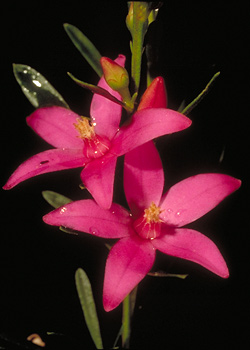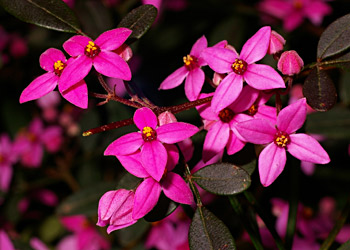
Garden Maintenance Tips - 3
Jeff Howes
Jeff continues with tips he has learned over many years of gardening with Australian native plants.....
Planting under Gum Trees
To maximise your success of getting your plants to grow, plant them as close to the trunk as possible. The reasons you do this are: there are very few tree feeder roots to rob your plant of nutrients and moisture. The second and less obvious is all about increasing the moisture of the soil. During rain, a lot of water runs down the trunks of the tree and hence toward your newly planted plant.
Poor Performers
Be ruthless with plants that do not perform in your garden. There are far too many new and exciting plants to try, so dig out the under-performers and consign them to the bin!
Group Your Plants
| |
 |
| |
Crowea 'Festival'
Photo: Brian Walters |
To get the best out of your plants, group plants with like conditions together. Low water requirement together, shade loving plants together, moisture loving plants together. Basic but vital.
Forget the Spring Flush
Design your garden so you have plants that flower at different times of the year and not only at spring. There is no better way to beat the winter doldrums than to see a patch of colour on a cold day - try Crowea 'Festival', or one of the many other late autumn/winter flowering natives.
No Feeding - Not True!
Do not be afraid to fertilise your native plants and orchids during the warmer months when they are growing. Use any fertiliser labelled suitable for native plants. Your plants will look much better and healthier for it.
If it's Native it will Grow Anywhere - Not True!
We have well over 20,000 plants growing in Australia and they are growing in deserts, along the coast and up to the Alps. When selecting plants for your garden, choose ones that naturally grow in similar conditions to yours, this will increase your chance of successfully growing them.
Pots
| |
 |
| |
Boronia fraseri
Photo: Brian Walters |
If you have soil that is too heavy to grow plants like Boronias etc. then buy a large plastic pot, cut the bottom out of it pace this on the ground (loosen the soil first) then fill the pot with potting mix and plant your plant. Finally, mulch the soil well around the base of the plant. The advantage of this method is eliminating the need to re-pot the plant every two years or so.
Habitat Gardening - Don't Fight the Site
Assess your site before you plant/dig/remove logs and rocks etc. Apart from planting native plants you will also be creating a habit style garden where native plants play a part of the food chain for any animals and insects etc. That is why it is important not to remove any rotted stumps/fallen timber (unless a nest for white ants) and puddles in your desire to obsessively tidy up. You should be aiming for retaining a wide diversity of habitats.
As you do not want to end up with a jungle, you will need to selectively hand weed or mow at the appropriate time as well as prune... all part of becoming a habitat gardener, more so if you use indigenous plants.
Landscaping
Think of the site when you are landscaping and the existing biodiversity. In paved areas water must be allowed to percolate downwards, therefore, no mortared joints. Use raised wooden decks rather than concrete for areas close to the house and boardwalks rather than paths. For areas away from the house try to create bird habitats, leaving dead trees if they contain potential nesting sites.
From 'Native Plants for New South Wales', newsletter of the Australian Plants Society (NSW), April 2005.
Australian Plants online - 2009
Australian Native Plants Society (Australia)
|